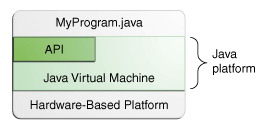☰
Java is a programming language and computing platform first released by Sun Microsystems in 1995. Java is a programming language built for the age of the Internet. There are lots of applications and websites that will not work unless you have Java installed, and more are created every day. Java is fast, secure, and reliable. From laptops to datacenters, game consoles to scientific supercomputers, cell phones to the Internet, Java is everywhere!
Imagine you're a software application developer. Your programming language of choice (or the language that's been foisted on you) is C or C++. You've been at this for quite a while and your job doesn't seem to be getting any easier. These past few years you've seen the growth of multiple incompatible hardware architectures, each supporting multiple incompatible operating systems, with each platform operating with one or more incompatible graphical user interfaces. Now you're supposed to cope with all this and make your applications work in a distributed client-server environment. The growth of the Internet, the World-Wide Web, and "electronic commerce" have introduced new dimensions of complexity into the development process. The tools you use to develop applications don't seem to help you much. You're still coping with the same old problems; the fashionable new object-oriented techniques seem to have added new problems without solving the old ones. You say to yourself and your friends, "There has to be a better way"!
Now there is a better way -- the Java programming language platform from Sun Microsystems.
Java is one of the world's most widely used computer language. Java is a simple, general-purpose, object-oriented, interpreted, robust, secure, architecture-neutral, portable, high-performance, multithreaded computer language. It is intended to let application developers "write once, run anywhere" (WORA), meaning that code that runs on one platform does not need to be recompiled to run on another.
Java technology is both a programming language and a platform.
Java is a high level, robust, secured and object-oriented programming language. And any hardware or software environment in which a program runs, is known as a platform. Since Java has its own runtime environment (JRE) and API, it is called platform.
In the Java programming language, all source code is first written in plain text files ending with the .java extension. Those source files are then compiled into .class files by the javac compiler. A .class file does not contain code that is native to your processor; it instead contains bytecodes — the machine language of the Java Virtual Machine1 (Java VM). The java launcher tool then runs your application with an instance of the Java Virtual Machine.

Because the Java VM is available on many different operating systems, the same .class files are capable of running on Microsoft Windows, the Solaris™ Operating System (Solaris OS), Linux, or Mac OS.

Through the Java VM, the same application is capable of running on multiple platforms.
A platform is the hardware or software environment in which a program runs. Some of the most popular platforms are Microsoft Windows, Linux, Solaris OS, and Mac OS. Most platforms can be described as a combination of the operating system and underlying hardware. The Java platform differs from most other platforms in that it's a software-only platform that runs on top of other hardware-based platforms.
The Java platform has two components:

The API and Java Virtual Machine insulate the program from the underlying hardware.
There are many devices where java is currently used. Some of them are as follows:
Application programs are stand-alone programs that are written to carry out certain tasks on local computer such as solving equations, reading and writing files etc.
Applets are small Java programs developed for Internet applications. An applet located in distant computer can be downloaded via Internet and executed on a local computer using Java capable browser.
Java, having been developed in 1991, is a relatively new programming language. At that time, James Gosling from Sun Microsystems and his team began designing the first version of Java aimed at programming home appliances which are controlled by a wide variety of computer processors.
Java was originally designed for interactive television, but it was too advanced for the digital cable television industry at the time. The language was initially called Oak after an oak tree that stood outside Gosling's office. Later the project went by the name Green and was finally renamed Java, from Java coffee. Gosling designed Java with a C/C++-style syntax that system and application programmers would find familiar.
In 1994, Gosling realized that such a language would be ideal for use with web browsers and Java's connection to the internet began. Sun Microsystems released the first public implementation as Java 1.0 in 1995.[1] It promised "Write Once, Run Anywhere" (WORA), providing no-cost run-times on popular platforms. Fairly secure and featuring configurable security, it allowed network- and file-access restrictions. Major web browsers soon incorporated the ability to run Java applets within web pages, and Java quickly became popular.
Major release versions of Java, along with their release dates: